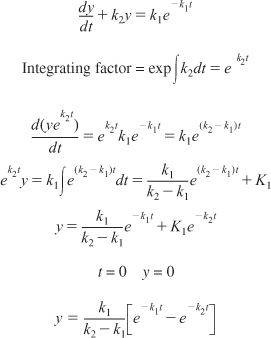A.3.A First-Order Ordinary Differential Equation
See www.ucl.ac.uk/Mathematics/geomath/level2/deqn/de8.html and DVD-ROM Appendix K.
![]()

Using the integrating ![]() , the solution is
, the solution is

Where K1 is a constant of integration.
Example A–1. Integrating Factor for Series Reactions

A.4 Numerical Evaluation of Integrals
In this section, we discuss techniques for numerically evaluating integrals for solving first-order differential equations.
- Trapezoidal rule (two-point) (Figure A.2). This method is one of the simplest and most approximate, as it uses the integrand evaluated at the limits of integration to evaluate the integral:

when h = X1 – X0.
Figure A.2. Trapezoidal rule illustration.

- Simpson’s one-third rule (three-point) (Figure A.3). A more accurate evaluation of the integral can be found with the application of Simpson’s rule:

where

Methods to solve
 in Chapters 2, 5, 11 and 12.
in Chapters 2, 5, 11 and 12.Figure A.3. Simpson’s three-point rule illustration.

- Simpson’s three-eighths rule (four-point) (Figure A.4). An improved version of Simpson’s one-third rule can be made by applying Simpson’s three-eighths rule:

where

Figure A.4. Simpson’s four-point rule illustration.

- Five-point quadrature formula.

- For N + 1 points, where (N/3) is an integer,

where

- For N + 1 points, where N is even,

where

These formulas are useful in illustrating how the reaction engineering integrals and coupled ODEs [ordinary differential equation(s)] can be solved and also when there is an ODE solver power failure or some other malfunction.
